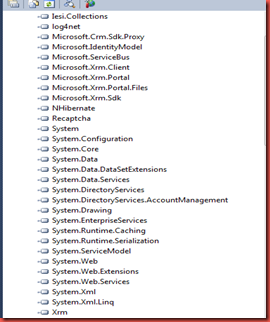As a hands on Development Manager I often get to lead by example, in my latest attempt to fast track re-development of some of our Java based web services to ASP.NET web service, I went about this using XRM based early bind method. I also explored SDK and JavaScript to execute the Dynamics rest API.
For a starter our web service methods roll up large datasets therefore JSON based service was obviously not suitable. Also the java based services made calls to multiple stored procedures through Hibernate frame work, the idea was to convert any calls to Dynamics CRM using XRM with LINQ and other bits and pieces using NHibernate framework.
I am keen to learn alternative methods and very open for feedback on the approach I have taken here.
Without further ado here are the steps.
1. Re-Compile XRM to include proxies for Dynamics CRM customisations. This was easily done by executing the following commands within the CrmSvcUtil.cmd file
REM $0\..\..\Microsoft.Xrm\bin\CrmSvcUtil /codeCustomization:"Microsoft.Xrm.Client.CodeGeneration.CodeCustomization, Microsoft.Xrm.Client.CodeGeneration" /out:Xrm\Xrm.cs /url:http://yourcrmurl/XRMServices/2011/Organization.svc /username:username@domain /password:userpassword /namespace:Xrm /serviceContextName:XrmServiceContext /serviceContextPrefix:Xrm
$0\..\..\Microsoft.Xrm\bin\CrmSvcUtil /codeCustomization:"Microsoft.Xrm.Client.CodeGeneration.CodeCustomization, Microsoft.Xrm.Client.CodeGeneration" /out:Xrm\Xrm.cs /url:http://yourcrmurl/YOURORG/XRMServices/2011/Organization.svc /domain:yourdomain /username:username /password:p: password /namespace:Xrm /serviceContextName:XrmServiceContext /serviceContextPrefix:Xrm
2. Create a ASP.NET web service project or WCF project in VS 2010 and references to XRM and SDK note the portal and the rest of the references are not required. For this POC and to keep things simple I have gone with ASP.NET web service.
3. Add a web service method which adds a contact record to your CRM when executed with valid data.
This web method takes some of the values for the contact record as argument and does some validations before generating new GUID and creating a new contact in the CRM. Valiation is done using LINQ to query CRM for existing records. On succesfull completion it returns a simple message too. Of course this is a work in progress and a number improvements can be made.
[WebMethod]
public String createContact(String contactSalutation, String contactFirstName, String contactLastName, String contactEmail1, String contactEmail2, String contactEmail3, String contactPhone, String contactFax, String addressLine1,
String addressLine2, String addressLine3, String city, String suburb, String stateProvince, String postalCode, String country,
String contactGUID)
{
List<NominatingOrganisation> nomorgList = new List<NominatingOrganisation>();
if (string.IsNullOrEmpty(contactEmail1) || string.IsNullOrEmpty(contactFirstName) || string.IsNullOrEmpty(contactLastName))
{
return "Email, Firstname and Lastname are required fields";
}
if (!string.IsNullOrEmpty(contactEmail1)) {
var contacts = from @contact in XrmContext.ContactSet where @contact.EMailAddress1.Equals(contactEmail1) select @contact;
if (contacts.ToList().Count > 0 ){
return "A contact with the email id already exists in the crm";
}
}
bool create = false;
if (string.IsNullOrEmpty(contactGUID))
{
create = true;
}
logger.Info("Inovoking createNewContact(String contactFirstName, service method with primaryContactEmail = " + contactEmail1);
if (create)
{
try
{
XrmContext.ClearChanges();
var newContact = new Contact();
newContact.Salutation = contactSalutation;
newContact.EMailAddress1 = contactEmail1.Trim();
newContact.EMailAddress2 = contactEmail2;
newContact.EMailAddress3 = contactEmail3;
newContact.FirstName = contactFirstName;
newContact.LastName = contactLastName;
newContact.Telephone1 = contactPhone;
newContact.Fax = contactFax;
newContact.Address1_Line1 = addressLine1;
newContact.Address1_Line2 = addressLine2;
newContact.Address1_Line3 = addressLine3;
newContact.Address1_City = city;
newContact.Address1_StateOrProvince = stateProvince;
newContact.Address1_PostalCode = postalCode;
newContact.Address1_Country = country;
newContact.adx_systemuser_contact = getSAGlobalRecordOwner();
newContact.Adx_username = contactEmail1.Trim();
newContact.Adx_LogonEnabled = true;
newContact.Id = Guid.NewGuid();
XrmContext.Detach(newContact);
XrmContext.AddObject(newContact);
XrmContext.SaveChanges();
} catch (Exception ex) {
return ex.Message;
}
}
logger.Info("Completing getNominatingOrganisationByPrimaryContact(String primaryContactEmail) = " + contactEmail1);
return "Contact successfully created";
}
4. Query the CRM for a list of entries and return it as an array of objects. This is simple enough and self explanatory. LINQ through XRM context to get a collection of records then loop through and prepare a List to return to the caller.
[WebMethod]
public List<Sector> getAllSectors()
{
logger.Info("Inovoking AllSectors()");
int count = 0;
var sectors = from @sector in XrmContext.sectorSet
where @sector.ParentSectorId == null orderby sector.name
select @sector;
List<Sector> sectorList = new List<Sector>();
foreach (var sector in sectors)
{
if (sector != null)
{
Sector sec = new Sector();
sec.sectorName = (String)sector.name;
sectorList.Add(sec);
count++;
}
}
logger.Info("Completing AllSectors() service request result count " + sectors.ToList().Count());
return sectorList;
}

Comments
Post a Comment